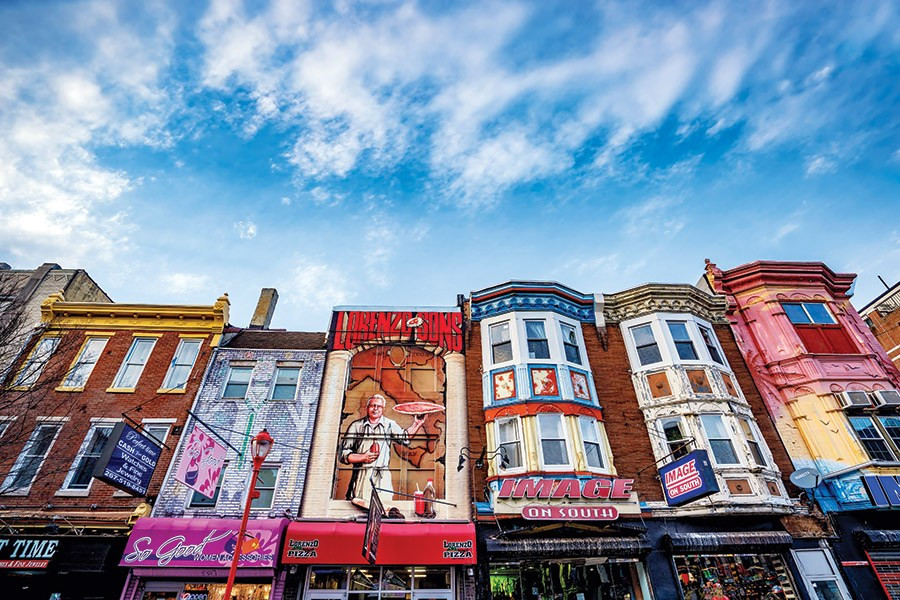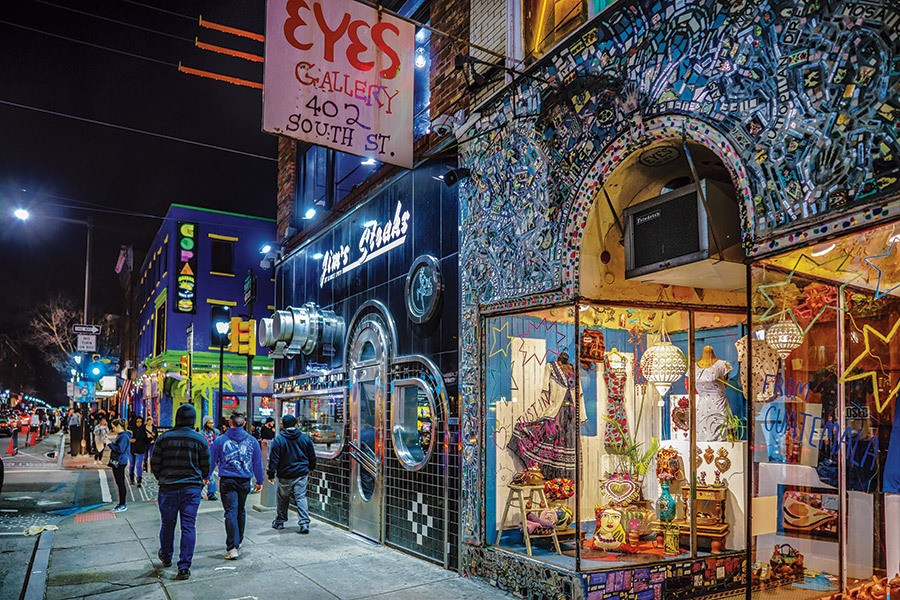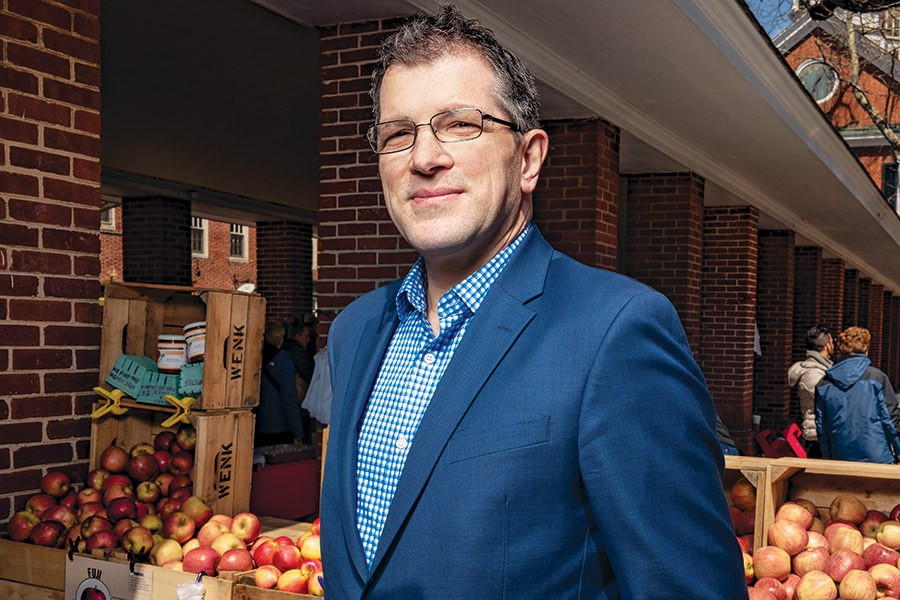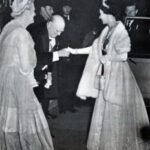South Street in Philadelphia, once celebrated as “the hippest street in town,” faces an identity crossroads as other parts of the city experience rapid growth. This exploration delves into the challenges and opportunities for South Street Philly, examining its rich history, current state, and the efforts to revitalize this unique urban corridor.
 Buildings along the 300 block of South Street
Buildings along the 300 block of South Street
A Street at a Crossroads: South Street Philly’s Struggle for Direction
For years, Mike Harris, the executive director of the South Street Headhouse District (SSHD), has been passionately working to maintain and improve South Street Philly. The SSHD, a business improvement organization with a long history in Philadelphia, is dedicated to ensuring the street’s continued vibrancy. Harris’s enthusiasm is palpable, even when discussing seemingly mundane details like sidewalk improvements, highlighting the dedication needed to revitalize a complex urban space like South Street.
However, the current reality of South Street Philly presents a stark contrast to Harris’s optimistic vision. While pockets of vibrancy exist, particularly around Headhouse Square, significant challenges are evident. The aftermath of a fire at a local landmark and numerous vacant storefronts paint a picture of a street struggling to maintain its former glory. The once-vibrant stretch of South Street Philly, from 2nd to 3rd Street, now features closed businesses, highlighting the economic difficulties the area faces.
Beyond this specific corner, the broader stretch of South Street Philly, from 9th Street to Front Street, reflects similar issues. Empty storefronts, some vacant for years, and establishments in need of renovation are common sights. The eclectic mix of businesses, ranging from tattoo parlors to adult boutiques, contributes to South Street’s unique character but also raises questions about its modern appeal and ability to attract a diverse range of visitors and businesses. Yet, interspersed within these challenges, there are signs of resilience: successful restaurants, established local businesses, and iconic Philadelphia institutions that continue to draw crowds.
This duality defines South Street Philly. By day, it can feel quiet, but as night falls, especially on weekends, the street transforms into a bustling entertainment hub. People from all corners of Philadelphia, representing diverse backgrounds, converge on South Street Philly to socialize, explore bars, and enjoy the street’s energetic atmosphere. This nighttime vibrancy, however, is only one facet of South Street’s identity, and the challenge lies in creating a thriving environment that caters to both daytime and nighttime economies, as well as residents and visitors alike.
South Street’s Enduring Legacy: From Hippest Street to Historic District
For many Philadelphians, South Street Philly holds a special place in their memories. Its unique blend of grit and charm has long been captivating, reminiscent of other iconic urban streets known for their counter-culture spirit. South Street’s appeal lies in its authentic urban fabric – a mix of history, diverse businesses, and a unique atmosphere that cannot be replicated.
South Street Philly’s legendary status is deeply rooted in its history. The Orlons’ 1963 hit song cemented its reputation as “the hippest street in town,” a title it arguably held for decades. Generations of Philadelphians have their own South Street stories, from witnessing legendary performances at the Theatre of the Living Arts to experiencing the vibrant nightlife and unique shops that defined different eras.
However, this rich legacy now seems to be both South Street Philly’s greatest asset and its biggest burden. While the historical cachet attracts visitors, it may also mask the street’s current struggles and hinder necessary evolution. South Street risks becoming a relic of its former self, clinging to past glories while failing to adapt to changing urban dynamics.
In contrast to South Street Philly’s stagnation, other Philadelphia neighborhoods have experienced remarkable revivals. Areas like Midtown Village, East Passyunk Avenue, and Frankford Avenue have successfully reinvented themselves, attracting new businesses and residents. Fabric Row, located just a block from South Street, has also seen a resurgence. The question then arises: why has South Street Philly lagged behind in this city-wide urban renewal?
Mike Harris points to the challenge of defining South Street Philly’s mission in this new era. Unlike other revitalized streets with clear identities, South Street’s strength lies in its eclectic mix. The goal, according to Harris, is to avoid homogenization while creating an environment that is both engaging and attractive, a delicate balance to strike. The core question for South Street Philly’s future revolves around reconciling its historical role as a neighborhood-serving retail corridor with its identity as an entertainment destination, all while preserving the unique bohemian character that made it iconic.
The Magic of South Street Philly: Gems Amidst the Challenges
Despite the challenges, South Street Philly retains a unique charm and hidden gems that continue to captivate those who venture beyond the surface. Eye’s Gallery, a long-standing institution on South Street, exemplifies this enduring appeal. Founded in 1968 by artists Julia and Isaiah Zagar, the gallery is a vibrant space filled with colorful folk art from Latin America.
 Scene from South Street
Scene from South Street
Julia Zagar’s continued presence and passion for fair trade and global artistry contribute to the gallery’s unique atmosphere. Eye’s Gallery is more than just a store; it’s a cultural experience, attracting tourists and loyal local customers alike. It represents the authentic, quirky spirit that defines the best of South Street Philly.
The Zagars and Eye’s Gallery are symbolic of the countercultural roots that are deeply embedded in South Street Philly’s DNA. However, the street’s history extends far beyond the bohemian era. Originally named Cedar Street and part of William Penn’s 17th-century city plan, South Street’s location near the river and jurisdictional boundaries fostered a history of diverse activities, including early nightlife and commercial ventures.
In the 19th century, South Street Philly became a significant hub for African-American communities and later served as a commercial center for European immigrants arriving through the Washington Avenue Pier. By the 20th century, it evolved into a bustling shopping district, home to fabric stores and iconic food establishments like Famous 4th Street Deli.
This historical context is crucial to understanding South Street Philly’s present situation. In the late 1950s, a proposed highway project threatened to transform South Street into a major expressway, casting a shadow over the neighborhood. The threat of demolition led to business closures and disinvestment, significantly impacting the once-thriving area.
However, this period of decline also paved the way for a new chapter in South Street Philly’s history. Artists and free spirits, drawn by affordable rents, began to revitalize the eastern end of the street, establishing galleries, theaters like the Theatre of the Living Arts (TLA), and unique eateries. The defeat of the expressway plan in 1972 solidified South Street’s resurgence as a countercultural haven.
The post-expressway era saw South Street Philly flourish as a hub for alternative culture. The opening of Essene natural foods store and Giovanni’s Room, a landmark for the LGBTQ+ community, further cemented its progressive identity. The emergence of a punk rock scene in the 1980s added another layer to its eclectic character. South Street’s international reputation grew, attracting tourists and solidifying its image as a cool and unconventional destination.
The Cycle of Change: South Street Philly’s Evolution and Challenges
South Street Philly’s trajectory reflects a common urban narrative: decline followed by artistic revival and subsequent commercialization. As the street became increasingly popular in the 1980s and 90s, national chains like Gap, Tower Records, and Blockbuster moved in. While this brought economic activity, it also led to the displacement of many local and independent businesses, diluting the unique character that had initially attracted visitors. South Street, in essence, risked transforming into a generic commercial strip, losing its original appeal.
 Mike Harris
Mike Harris
Mike Harris describes this cyclical history, noting that the recession of 2008 marked another turning point for South Street Philly. However, even before the recession, the street was facing challenges. Chain stores began to depart, and South Street became a mix of businesses that no longer effectively served local residents nor offered a compelling destination experience. Issues with bar over-saturation and negative perceptions, partly stemming from events like the 2001 Mardi Gras Riot, further complicated the street’s image.
Despite these challenges, Harris argues against romanticizing the past and emphasizes the need to recognize the present realities of South Street Philly. He encourages a nuanced perspective, urging people to define what they consider “good” when reflecting on South Street’s history. The current focus, according to Harris, should be on highlighting the street’s existing “gems” and hidden attractions, while working towards a more sustainable future.
South Street Philly’s current situation is complex. It’s not in complete decline, still attracting a million visitors annually, but it’s also not thriving to its full potential. This “stuck” state presents a significant challenge for revitalization efforts. It’s harder to implement dramatic changes when the street isn’t perceived as completely broken, yet incremental improvements are needed to address the underlying issues.
Revitalizing South Street Philly: A Path Forward
Philadelphia’s success stories in neighborhood revitalization offer potential models for South Street Philly. Midtown Village and East Passyunk Avenue’s transformations were driven by strategic property acquisition and curated business development. These areas, once in decline, were revitalized by attracting creative businesses, restaurants, and services that catered to the evolving needs of the surrounding neighborhoods. These examples highlight the importance of a comprehensive and coordinated approach to urban renewal.
Mike Harris envisions a similar revitalization strategy for South Street Philly, focusing on attracting businesses that serve the needs of the growing residential populations in Society Hill and Queen Village. He recognizes the irony that as these neighborhoods flourished, South Street’s appeal to residents diminished. Harris aims to bridge this gap by attracting businesses that cater to local needs while complementing South Street’s existing character.
Harris’s wish list for South Street Philly includes a brewpub, a distillery tasting room, an arcade, and more family-friendly businesses like toy stores. He points to the recent opening of Rocket Fizz candy store as a positive step. The long-delayed supermarket project for the 200 block remains a key priority. Harris believes that these new businesses can coexist with existing establishments, creating a more diverse and appealing retail landscape. His vision is encapsulated in a potential tagline: “Come for your old favorites, discover some new ones while you’re here,” aiming to balance preservation and progress.
Harris draws inspiration from successful entertainment and retail districts in other cities, such as Carson Street in Pittsburgh, Frenchmen Street in New Orleans, and Haight-Ashbury in San Francisco. These areas have managed to balance the needs of local residents with the attraction of visitors, creating vibrant urban environments that are both authentic and economically viable. This balance is crucial for South Street Philly, ensuring it remains a destination for all Philadelphians, unlike the more localized appeal of revitalized streets like Frankford Avenue and East Passyunk.
Overcoming Obstacles: Landlords and the Future of South Street Philly
The primary obstacle to South Street Philly’s revitalization lies in the fragmented property ownership. Unlike the successful models of Midtown Village and East Passyunk, where consolidated property ownership facilitated coordinated development, South Street is characterized by numerous, often absentee, landlords. This decentralized ownership makes it challenging to implement a cohesive revitalization strategy.
Paul Levy, head of the Center City District, emphasizes the importance of “responsible landlords” who are invested in the long-term vitality of the neighborhood. He questions whether this type of coordinated thinking was present on South Street in previous decades. The example of Michael Axelrod, a New York developer owning numerous South Street properties, including a prominent vacant corner lot, illustrates this challenge. The economic rationale behind long-term vacancies, driven by the pursuit of higher rents, hinders street-level vibrancy and overall progress.
The city’s role in addressing these challenges is also debated. Suggestions range from vacancy taxes to more proactive engagement from city leadership in attracting desirable businesses to South Street Philly. Stephen Starr, a prominent Philadelphia restaurateur, believes the city should actively court retailers for South Street, similar to efforts to attract major corporations like Amazon.
A positive development is the acquisition of 11 Axelrod properties by Midwood Investment & Development, a New York-based firm with a positive track record in other parts of Philadelphia. Midwood’s commitment to reviewing leases and attracting relevant retail, particularly food and dining establishments, offers a glimmer of hope for a more curated and strategic approach to tenant selection on South Street Philly.
However, the process of change remains incremental. Revitalization on South Street Philly will likely occur store by store, making progress appear slow and gradual. This necessitates patience and sustained effort from all stakeholders.
A Community Committed: The Heart of South Street Philly
Despite the visible challenges, Mike Harris emphasizes the existing strengths of South Street Philly. He believes that local residents already utilize South Street businesses more than they acknowledge, pointing to established restaurants and services. He acknowledges the need for aesthetic improvements, such as storefront renovations, to enhance perceptions of the street.
Harris highlights the positive indicators: the presence of over 400 businesses in the SSHD, declining crime rates, and a decrease in head shops. He has implemented visible improvements, including enhanced cleaning services, new lighting, and traffic management measures. Events like Spring Fest and family-friendly holiday celebrations aim to create a more welcoming atmosphere. The upcoming Headhouse Square plaza renovation, while scaled back from initial plans, represents a significant capital improvement project.
Despite these positive developments, the overall revitalization of South Street Philly may be a slower process than the rapid transformations seen in other neighborhoods. It may be a gradual climb out of a prolonged cycle of stagnation. However, a new generation of business owners on streets like Fabric Row, adjacent to South Street, offers a source of optimism.
The emergence of businesses like Paradigm Gallery, Yowie, and Hungry Pigeon on Fabric Row demonstrates a renewed entrepreneurial spirit focused on authenticity and unique experiences. These businesses, led by engaged owners like Sara McCorriston of Paradigm Gallery, embody the spirit of the original South Street Philly, emphasizing its inherent “weirdness” and embracing its diverse character. This new generation understands the importance of preserving South Street’s unique identity as a destination for everyone, recognizing that its East Village-like flair and diverse appeal are essential components of Philadelphia’s urban fabric.
Ultimately, the future of South Street Philly depends on embracing its complex identity, fostering collaboration among stakeholders, and recognizing the enduring commitment of the community that continues to believe in its potential. By focusing on the existing strengths, supporting new and existing businesses, and celebrating its unique history, South Street Philly can reclaim its position as a vibrant and iconic Philadelphia destination.

